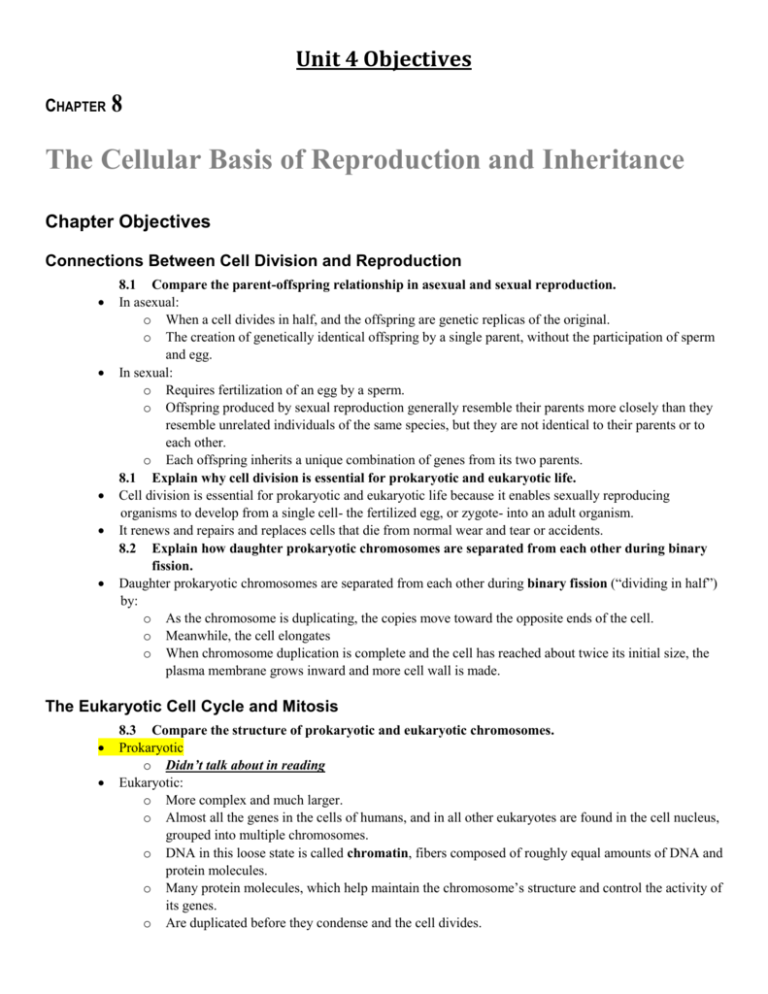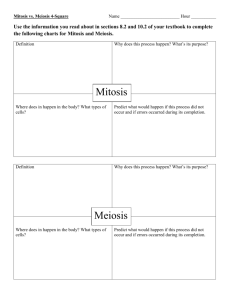Unit 4 Objectives - Hinsdale South High School
advertisement

Unit 4 Objectives CHAPTER 8 The Cellular Basis of Reproduction and Inheritance Chapter Objectives Connections Between Cell Division and Reproduction 8.1 Compare the parent-offspring relationship in asexual and sexual reproduction. In asexual: o When a cell divides in half, and the offspring are genetic replicas of the original. o The creation of genetically identical offspring by a single parent, without the participation of sperm and egg. In sexual: o Requires fertilization of an egg by a sperm. o Offspring produced by sexual reproduction generally resemble their parents more closely than they resemble unrelated individuals of the same species, but they are not identical to their parents or to each other. o Each offspring inherits a unique combination of genes from its two parents. 8.1 Explain why cell division is essential for prokaryotic and eukaryotic life. Cell division is essential for prokaryotic and eukaryotic life because it enables sexually reproducing organisms to develop from a single cell- the fertilized egg, or zygote- into an adult organism. It renews and repairs and replaces cells that die from normal wear and tear or accidents. 8.2 Explain how daughter prokaryotic chromosomes are separated from each other during binary fission. Daughter prokaryotic chromosomes are separated from each other during binary fission (“dividing in half”) by: o As the chromosome is duplicating, the copies move toward the opposite ends of the cell. o Meanwhile, the cell elongates o When chromosome duplication is complete and the cell has reached about twice its initial size, the plasma membrane grows inward and more cell wall is made. The Eukaryotic Cell Cycle and Mitosis 8.3 Compare the structure of prokaryotic and eukaryotic chromosomes. Prokaryotic o Didn’t talk about in reading Eukaryotic: o More complex and much larger. o Almost all the genes in the cells of humans, and in all other eukaryotes are found in the cell nucleus, grouped into multiple chromosomes. o DNA in this loose state is called chromatin, fibers composed of roughly equal amounts of DNA and protein molecules. o Many protein molecules, which help maintain the chromosome’s structure and control the activity of its genes. o Are duplicated before they condense and the cell divides. o o o o o o The DNA molecule of each chromosome is replicated, and new protein molecules attach as needed. Each chromosome now consists of two copies called sister chromatids, which contain identical copies of the DNA molecule. The two sister chromatids are joined together especially tightly at a narrow “waist” called the centromere. When the cell divides, the sister chromatids of a duplicated chromosome separate from each other. Once separated from its sister, each chromatid is called a chromosome, and it is identical to the chromosome the cell started with. One of the new chromosomes goes to one daughter cell, and the other goes to the other daughter cell. Alike: o Both chromosomes contain one long DNA molecule bearing hundreds or thousands of genes and, attached to the DNA, a number of protein molecules. 8.4 Describe the stages of the cell cycle. Identify when DNA is replicated, chromosomes are sorted, and two new cells are formed. Stages: o Growing stage: Called interphase. The cell roughly doubles everything in its cytoplasm and precisely replicates its chromosomal DNA. Where most of cell cycle is spent Time when a cell’s metabolic activity is very high and the cell performs its various functions within the organism. A cell makes more cytoplasm. Increases its supply of proteins, creates more cytoplasmic organelles (such as mitochondria and ribosomes), and it grows in size. Chromosomes duplicate during this period. Can be divided into three subphases: G1 phase o “first gap” o Cell grows S phase o Chromosomes are duplicated o Continues to grow o S stands for synthesis of DNA (DNA replication) G2 phase o “Second gap” o Grows more as it completes preparation for cell division. o The actual cell division: Called the mitotic phase (M phase) The cell actually divides Divided into two overlapping stages, called mitosis and cytokinesis Mitosis: o The nucleus and its contents-most importantly the duplicated chromosomes-divide and are evenly distributed, forming two daughter nuclei Cytokinesis: o Usually begins before mitosis ends o The cytoplasm is divided in two. The combination of mitosis and cytokinesis produces two genetically identical daughter cells, each with a single nucleus, surrounding cytoplasm stocked with organelles, and a plasma membrane. Each newly produced daughter cell may then proceed through G1 and repeat the cycle. Unique to eukaryotes and is the evolutionary solution to the problem of allocating identical copies of all the separate chromosomes to two daughter cells. Where two new cells are formed 8.5 List the phases of mitosis and describe the events characteristic of each phase. Recognize the phases of mitosis from diagrams and micrographs. 8.6 Compare cytokinesis in animal and plant cells. 8.7–8.8 Explain how anchorage, cell density, and chemical growth factors control cell division. 8.9 Explain how cancerous cells are different from healthy cells. Distinguish between benign and malignant tumors, and explain the strategies behind some common cancer treatments. 8.10 Describe the functions of mitosis. Meiosis and Crossing Over 8.11 8.12 8.12 8.13 Explain how chromosomes are paired. Distinguish between autosomes and sex chromosomes. Distinguish between somatic cells and gametes and between diploid cells and haploid cells. Explain why sexual reproduction requires meiosis. List the phases of meiosis I and meiosis II and describe the events characteristic of each phase. Recognize the phases of meiosis from diagrams and micrographs. 8.14 Describe the similarities and differences between mitosis and meiosis. Explain how the result of meiosis differs from the result of mitosis. 8.15–8.17 Explain how independent orientation of chromosomes at metaphase I, random fertilization, and crossing over contribute to genetic variation in sexually reproducing organisms. Alterations of Chromosome Number and Structure 8.18 8.19 8.20 8.21 8.22 8.23 Explain how and why karyotyping is performed. Describe the causes and symptoms of Down syndrome. Define nondisjunction, explain how it can occur, and describe what can result. Describe the consequences of abnormal numbers of sex chromosomes. Explain how new species form from errors in cell division. Describe the main types of chromosomal changes. Explain why cancer is not usually inherited.









